|
TOTAL:
|
$0.00 |

|

|
|
Your On-Line Source for Latin Music Downloads!
|

|

Los Ases de la Timba
This artist has albums available.
|

| Album Name | Preview | Style | Price | |
|---|---|---|---|---|
| Aqui Estan Los Ases |
|
Timba | $12.99 |

|

Musicians on "Aqui Estan Los Ases" By Los Ases de la Timba:
Pedro Pablo Gutiérrez
Bajo
Cecilio O. Valido
Saxo
Karina Gutiérrez
Piano y teclado
Mario "Mayito" Gavilán
Coros
Jorge LP Torres "Papiosko"
Conga
Wilmer "El Fine" Muñoz
Coros
Yerisloy Serrano "Jerry"
Timbal
Armando "Mandy"
Voz en 1,2,5,8
Carlos Amores
Guiro
Tirso Duarte
Voz en 1,4,7,10
Frank Padron
Trompeta
Michel Maza
Voz en 1,3,6,9
Jesús "El Indio" Chappottin
Trompetas
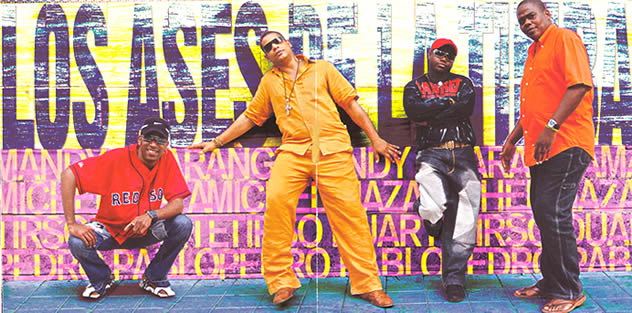
Los Ases de la Timba: Aquí están Los Ases
Technical analysis by Kevin Moore of www.TIMBA.com
An increasingly common phenomenon in today's bizarre and unsettled musical economy is the "all-star studio band" - a collection of marquée names thrown together to quickly churn out a commercial product. Most such projects are lackluster at best -- no amount of individual talent and fame can make up for the chemistry that results from months of rehearsing, gigging and touring.
To understand how Los Ases de la Timba bucked this trend to make one of the best timba albums of the 2000s, you have to take a long look at the cast of characters. Pedro Pablo and Michel Maza spent years together in the original Charanga Habanera. Maza and Tirso Duarte were founding members of la Charanga's equally-amazing second incarnation. Pablo, Michel and Mandy Cantero all collaborated in perhaps the greatest version of Charanga Forever. Still later, Duarte and Cantero became founding members of Pupy Pedroso's Los Que Son Son. Most of the rhythm section plays together regularly in Havana in Pedro Pablo's Rebambaramba, an excellent group with Envidia releases of its own. So while appearing on the surface to be a studio all-star band, Los Ases de la Timba is actually Rebambaramba with three all-star singers who have worked together in various combinations, and one wildcard outsider who turns out to be the straw the stirs the drink.
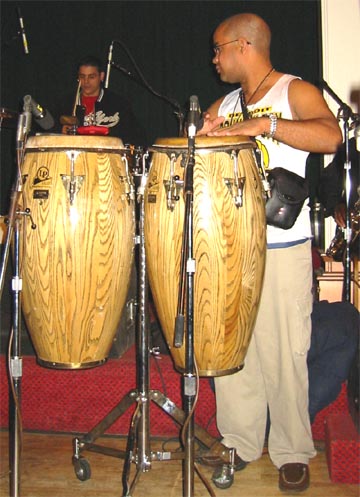 The
wildcard is ex-Klímax conguero Jorge Luis Torres "Papiosco",
whose only historical connection with the others is his brilliant work on Michel
Maza's first two studio albums. Papiosco's unique and soulful approach to timba
conga-drumming provides perhaps the most original aspect of the CD.
The
wildcard is ex-Klímax conguero Jorge Luis Torres "Papiosco",
whose only historical connection with the others is his brilliant work on Michel
Maza's first two studio albums. Papiosco's unique and soulful approach to timba
conga-drumming provides perhaps the most original aspect of the CD.
Papiosco's work on this album will get its own chapter in the upcoming second volume of our online book series, which will fully explain the "gears" of timba. The basic premise is that each timba band develops an elaborate system of live performance breakdowns and bloques which becomes part of its rhythmic style or "sello".
The book will attempt to explain all the gears of all the major bands, but for our short study of Los Ases, we'll concentrate on one gear, masacote, in which the bass drops out and the spotlight is on the creativity of the conguero. Diverging from the more common approach used by Charanga Habanera and Revé, where the congas drop out at the beginning of the breakdown before re-entering, Papiosco's masacotes begin immediately and contain an extraordinarily amount of rhythmic variety. The degree to which they're improvised or pre-composed is a mystery because we can't hear this band live - especially now that the members are scattered all over the Western Hemisphere! What we do know is that there are 37 masacotes on this album and no two are the same.
To put things in perspective, let's look back at some of the most creative examples of the masacote gear that have evolved over the years. Prior to timba, the conga was primarily a time keeper, playing a predictable part throughout the arrangement unless called upon to play a solo, bloque or fill. The timba congueros developed a variety of systems for dropping out and re-entering with interesting parts - some pre-composed and some improvised.
Alexis Cuesta "Mipa" with Manolín el Médico de la Salsa: Mipa's creative improvised marchas weren't limited to masacote sections. Coming at any point in the arrangement, his creative conga parts [audio 1] [audio 2] [source] earned him the ultimate respect of his peers when he was chosen as the conguero for Team Cuba in 1998. LPM will soon be releasing a series of educational videos showing closeups of him in the recording studio with his new band El Pikete.
Orlando Mengual with Charanga Habanera: Mengual entered la Charanga in 1998 at the same time as Los Ases singer Tirso Duarte. The band had already established a sello in which the conguero (Victor Sagarra) would drop out for one to four claves, and then re-enter with a marcha that conversed melodically with the tresillo-based bell pattern. [audio 1] [source]. The second Charanga Habanera continued this basic approach, but Mengual greatly expanded the range of possibilities for the conga marchas, basing many of his ideas on the pilón rhythm. [audio 2][source].
Tomasito Cruz with Paulito FG: If the seed rhythm for Mengual's creations was pilón, it was songo, and specifically bota, which provided the point of embarkation for Paulito FG's songo con efectos gear [audio 1] [audio 2] [studio source], described in detail in our Tomás Cruz Conga Method, Vol. II. The gear was used extensively in the live performances of 1998 before Tomás relocated to Miami, where he's now the leader of The Cuban Timba All Stars. The songo con efectos gear was extremely soloistic and also involved improvisation on the part of the drummer, Yoel Páez.
Papiosco with Los Ases de la Timba: Since the band has never performed live, we have no way of knowing the extent to which Papiosco's masacote parts are improvised or pre-composed, but they're extremely varied and creative. As you can hear and see in the examples below, the title track, Aquí están Los Ases, has six masacote sections and each one is distinctly different.
Note: These transcriptions are not complete - they show the "speaking tones" but not the "manoteo" (the softer tones used to keep time).
LEGEND: T = Tumba (low conga open) c = conga (high conga) M = Muff (low conga muff)
Comparing the six examples, we can see that Papiosco often
enters, and almost always exits the masacote in the same way, but what he does
during the masacote is different each time. Each has
a basic rhythmic motif which repeats with variations, but each is unique.
In the examples below, each row represents one clave. For dancers it's one basic step. Read each example row by row to get the full rythmic movement of the conguero as he plays through that particular section of the song.
Aquí están Los Ases - masacote 1
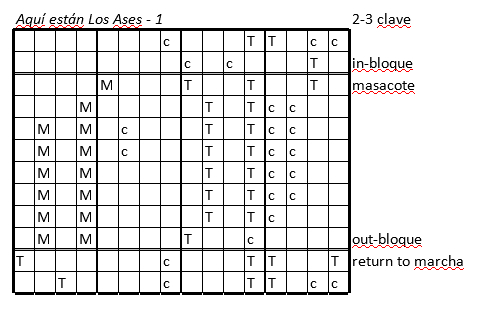
The first masacote is based on a coro borrowed from Yo tengo el don, the title track of Rebambaramba's first CD. The conga part is quite similar to the marcha makuta [source] that Tomás Cruz uses on Paulito FG's Llamadas anónimas [source].
Aquí están Los Ases - masacote 2
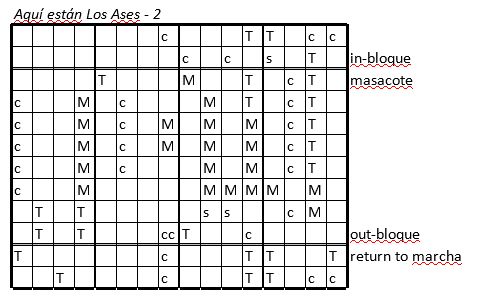
The next three masacotes introduce the lead vocalists, beginning with Tirso Duarte who paraphrases the gorgeous "eso es ... para que nada te pueda pasar" coro he invented for the second version of Charanga Habanera's classic Usa condón. Papiosco's marcha is completely different, but based on a well-developed idea which repeats with variations.
Aquí están Los Ases - masacote 3
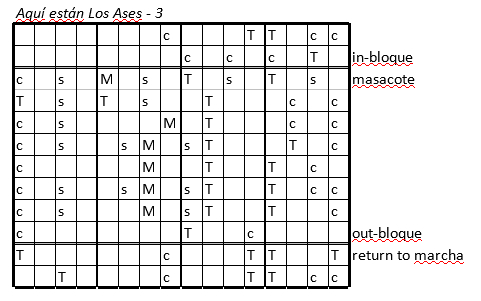
The next singer is Michel Maza, who also refers to one of his trademark coros - in this case "qué será qué será qué será cuando yo no esté". This is one of the more abstract conga parts. It begins with a bit of a cumbia flavor and then seems to briefly flirt with the idea of imitating the coristas.
Aquí están Los Ases - masacote 4
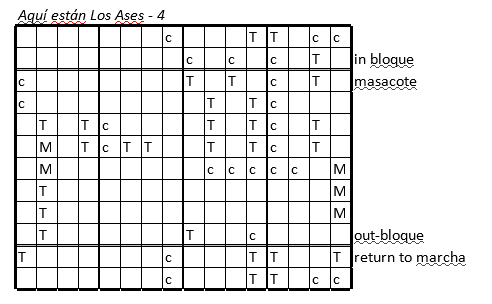
Mandy Cantero began his career in 1998 with Bamboleo and Charanga Forever, but it was his incredible work on Pupy Pedroso's Qué cosas tiene la vida that firmly established him as the top tier lead vocalist who can now comfortably hold his own aside superstars like Michel and Tirso. After listening to this excerpt dozens of times to transcribe the conga part, I found myself mesmerized by the vocal track. Mandy finds the perfect sweet spot between singing and speaking. His opening phrase doesn't contain a single "note" per sé, but his vocal inflections cover well over an octave of expressive range. The interplay between the vocals and congas is also sublime. For example:
Mandy: te digo a ti
congas: T T c
Mandy: escucha
congas: T T c T
Aquí están Los Ases - masacote 5
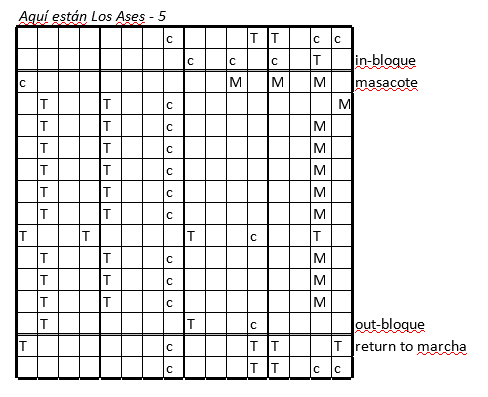
The fifth masacote introduces yet another marcha, this time based on a displaced tresillo.
Aquí están Los Ases - masacote 6
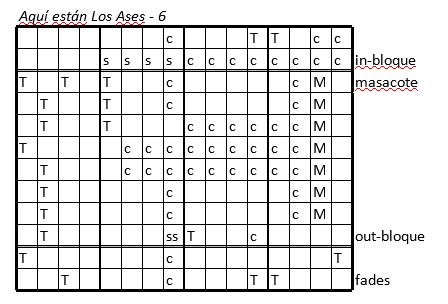
Papiosco saves his wildest adventure for last.
All told, this album has an amazing 37 masacotes -- no two exactly the same. After studying them all, certain patterns begin to emerge but the amount of inspired variation is exceptional, even for a top timba album.
In summary, while the three brilliant singers are obviously the first thing that calls attention to this album, it has so much going on under the hood rhythmically that it continues to improve after dozens of listenings and to provide a serious course of study for any conguero, whether an aspiring student or an established professional.